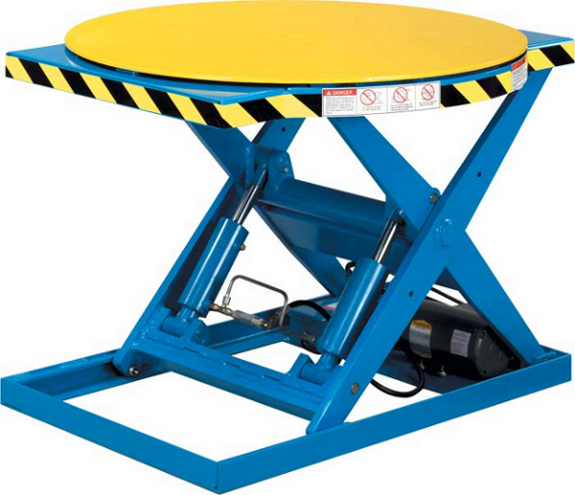by Danille Bettridge, Web Store Specialist

What is a lift table?
Lift tables are devices that allow objects to be raised and lowered on a platform to reach ergonomic and accessible heights for specific tasks or purposes. A lift table is typically made up of the following major components:
- The base supports the rest of the assembly and is located at the bottom of the lift table.
- The base must be strong, rigid, and stable.
- The base is usually made to be placed on the floor, but it can also be built into a pit. It can also include wheels or casters to create a more portable and mobile lift table.
- The leg assemblies provide true, level vertical motion while supporting the platform or top. The different types of lifting mechanisms/legs available on lift tables are:
- Scissor - Scissor style lifts are by far the most common type of lift table. The power source moves two sets of legs that are connected by shafts at the center pivot points, as well as at the upper and lower hinged ends. Rollers are attached to the other end of the legs, which move back and forth on the base frame, and along the underside of the platform.
- Screw – These types of lifts rely upon the helical thread of a screw, which moves the table along the length of the screw as it rotates.
- Rack & Pinion - Vertical motion is provided by the drive of a rack (gear) and its related pinion (essentially a linear bar with mating teeth). The rotation of the rack moves the table along the track provided by the pinion.
- Telescoping - Linear platforms are stored within the middle cavity of a larger cylinder, sometimes in several sections, creating a small footprint in retracted form.
- Articulated – These lifts have jointed arms that are extended by the use of linear actuators. These can typically offer some horizontal movement in addition to vertical elevation.
- Chain & Sprocket - A rotating sprocket with a vertically oriented chain drive supplies the required force to raise the lift table.
- Objects that you want lifted are placed on the platform, or top, of the lift table.
- The platform can be any size that is compatible with the base and legs. With most lift tables, the platform can be no smaller than the length or width of legs/base. Within limits, platforms can be larger than the legs/base.
Platforms can have a variety of options such as conveyor tops, turntables, tilt tops, non-slip textures, mounted clamps, or special work fixtures.
- Manual - Manual lifting is powered by a crank, pump, racket, or screw that relies upon the operator for stimulation. This is prominent in light-duty lift tables, but might be suitable for heavy or high-volume loading.
- Pneumatic - Elevation is accomplished by the use of a pressurized air cylinder in conjunction with a compression mechanism. Occasionally, an air spring is used instead.
- Hydraulic - Pressurized hydraulic fluids power a linear actuator to raise the table. An accompanying hydraulic pump is required.
- Electric - Electric motors provide a rotational power source that can power elevation with the use of a mechanical advantage, such as a rack/pinion drive or a chain lift.
- Hand operated
- Foot operated
How are lift tables used?
Lift tables can be used in almost any industry, indoors and outdoors. Industries that commonly use lift tables include woodworking, manufacturing, metalworking, paper, printing and publishing, warehousing and distribution, drafting, equipment and vehicle service, heavy machinery, and transportation. Common uses of lift tables include:
- Vehicle loading and docking operations
- Work positioning and ergonomic handling
- Load positioning (such as when integrated into conveyor systems)
- Work piece feeding/offloading
- Furniture upholstery
- Dog grooming
- Accessing high work
- Handling long and/or heavy work pieces
- Multilevel handling and assembling
- Loading and unloading pallets
- Working under or over equipment and vehicles
What are the most important considerations when deciding on a lift table?
- Capacity - This is the maximum weight the table is rated to handle. Tables capable of lifting five [short] tons or more are common.
- Size - This includes the physical dimension of the lift table including the base and platform that would be compatible with the objects that you plan to lift.
- Elevation - This is the elevation capability of lift table, from collapsed height to fully elevated height. Depending on how the lift table is to be used, it might also be important to consider how long the platform takes to move up and down.
- Power Source- Depending on the location you plan on using the lift table at, it may be necessary to consider to what type of power you will have access to in order to operate the lift table. See “Power Source” above for the different power source options.
- Special Features - Depending on how you plan to use the lift table, you might need it to do more than simply travel vertically. For instance, you might need a rotating platform, mobile base, tilting platform, and so on.
Lift tables are designed to fit your needs. There are infinite options you can choose from; making lift tables a great solution to improve various everyday tasks in many work places. Contact us at store@raymondhandling.com or 1-844-445-1119 if you need assistance in selecting a customized lift table or have any questions .
You can view our featured lift table selection by clicking here> Warehouse Lift Tables
